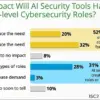
According to a research report published by Spherical Insights & Consulting, the Global Defense Cyber Security Market Size is to grow from USD 13.97 billion in 2022 to USD 48.78 billion by 2032, at a Compound Annual Growth Rate (CAGR) of 13.3% during the projected period.
The Defense Cyber Security global market research studies offer an in-depth analysis of current industry trends, development models, and methodology. Production processes, development platforms, and the actual product models are some of the variables that have a direct impact on the market. The aforementioned characteristics can drastically vary in response to even minor changes in the product profile. The study provides a thorough explanation of each of these elements of Aerospace & Defense.
Request To Download Free Sample copy of the report @ https://www.sphericalinsights.com/request-sample/2490
Market Overview
Cybersecurity includes the protection of assets from cybercrime, terrorism, and other network service disruptions that may disrupt daily operations. It can be accomplished by actively monitoring IT assets, exposing outages or malicious movement, and responding quickly to interruptions. Similarly, the defense industry is moving toward the digital age, with increasing digital data generation, storage, and transmission.
The global market is Defense Cyber Security Market robust growth due to:
Rising Frequency of Cyber Threats – Increased cyberattacks targeting critical military infrastructure and defense networks.
Growing Defense Expenditure – Nations are allocating larger budgets to strengthen cybersecurity frameworks in their armed forces.
Adoption of Advanced Technologies – Integration of AI, machine learning, and zero-trust architectures for proactive threat detection and response.
Buy Now this report: https://www.sphericalinsights.com/checkout/2490
Hardware Segment to Witness Strong Growth Amidst Infrastructure Modernization Initiatives
The hardware segment is poised to register substantial growth in the global defense cyber security market throughout the forecast period. This expansion can be primarily attributed to the large-scale modernization of defense IT infrastructures by major nations, including the United States, China, Japan, and India. These governments are making strategic investments in advanced hardware systems such as secure servers, firewalls, encrypted communication devices, and intrusion detection systems to reinforce their cyber defenses.
Moreover, the growing incidence of cyberattacks on military communication networks, weapon systems, and battlefield platforms has intensified the demand for robust physical cybersecurity infrastructure. This has prompted defense agencies to collaborate with established technology providers and defense contractors to upgrade legacy systems and implement more resilient security hardware. As a result, the hardware segment is anticipated to be a key driver of overall market growth in the coming years.
Cyber Threat Protection Segment to Dominate the Market Landscape
Among the various solution types, the cyber threat protection segment is expected to capture the largest share of the global defense cyber security market during the forecast period. The segment’s growth is fueled by the escalating need to counteract sophisticated cyber threats targeting defense ecosystems. As cyber warfare evolves, defense organizations are increasingly relying on proactive threat protection platforms that can identify, neutralize, and prevent malware, ransomware, phishing, and zero-day vulnerabilities in real time.
These solutions are critical for safeguarding mission-critical operations, protecting classified data, and ensuring the integrity of defense networks. Advanced capabilities such as behavioral analytics, AI-powered detection, endpoint protection, and automated incident response are key features driving the adoption of cyber threat protection tools across global military and defense sectors.
As governments strengthen their digital resilience, the cyber threat protection segment is set to remain a dominant force in the defense cyber security landscape.
List of Key Companies
• Lockheed Martin
• The Thales Group
• BAE Systems
• General Dynamics
• Northrop Grumman Corporation
• Raytheon Technologies
• Booz Allen Hamilton
• Leonardo
• Leidos
• L3Harris Technologies
• Others
Market Challenges
Evolving Nature of Cyber Threats
One of the primary challenges in the defense cyber security market is the rapid evolution of cyber threats. State-sponsored attacks, advanced persistent threats (APTs), and zero-day vulnerabilities are becoming increasingly sophisticated. Keeping pace with these threats requires continuous innovation, which can strain resources and outpace existing security infrastructures.
Integration with Legacy Systems
Many defense organizations still rely on outdated IT systems and legacy infrastructure that are incompatible with modern cybersecurity solutions. Integrating advanced security frameworks with these legacy platforms poses technical difficulties and increases vulnerability to breaches during the transition period.
Shortage of Skilled Cybersecurity Professionals
The global shortage of qualified cybersecurity personnel is particularly acute in the defense sector, where security clearance and specialized knowledge are required. This talent gap makes it challenging for defense agencies to maintain robust, round-the-clock protection against complex cyberattacks.
High Implementation Costs
Deploying advanced defense cyber security systems-particularly those involving AI, machine learning, and zero-trust architecture-requires significant financial investment. These high costs can be a barrier, especially for developing countries or regions with constrained defense budgets.
Research Objectives
To Analyze Market Dynamics and Growth Drivers: Examine the key factors propelling the growth of the defense cyber security market, including rising cyber threats, modernization of defense IT infrastructure, and increased government investments in digital defense systems.
To Segment and Forecast the Market by Component, Solution, Deployment, and Region: Provide a detailed segmentation of the market based on hardware, software, and services; evaluate solutions such as cyber threat protection, threat intelligence, and content security; and offer forecasts across regions including North America, Europe, Asia-Pacific, Latin America, and the Middle East & Africa.
Recent Development
In April 2023, Thales announced the launch of SCRED, a collaborative project involving 11 French companies and organizations focused on cyber security. The project’s goal over the next three years is to build a single platform to provide cyber threat intelligence services to businesses and government agencies.
Access Full Report: https://www.sphericalinsights.com/reports/defense-cyber-security-market
Market Segment
This study forecasts revenue at global, regional, and country levels from 2020 to 2032. Spherical Insights has segmented the Global Defense Cyber Security Market based on the below-mentioned segments:
Global Defense Cyber Security Market, By Platform
• Software & Service
• Hardware
Global Defense Cyber Security Market, By Solution
• Cyber Threat Protection
• Threat Evaluation
• Content Security
• Others
Global Defense Cyber Security Market, By Type
• Critical Infrastructure Security & Resilience
• Application Security
• Cloud Security
• Others
Global Defense Cyber Security Market, By End User
• Land Force
• Naval Force
• Air Force
Regional Segment Analysis of the Global Defense Cyber Security Market
North America (U.S., Canada, Mexico)
Europe (Germany, France, U.K., Italy, Spain, Rest of Europe)
Asia-Pacific (China, Japan, India, Rest of APAC)
South America (Brazil and the Rest of South America)
The Middle East and Africa (UAE, South Africa, Rest of MEA)
What’s covered in the report?
1. Overview of the Defense Cyber Security Market.
2. The current and forecasted regional (North America, Europe, Asia-Pacific, Latin America, the Middle East and Africa) market size data for the Defense Cyber Security Market, based on segment.
3. Defense Cyber Security Market trends.
4. Defense Cyber Security Market drivers.
5. Analysis of major company profiles.
FIVE FORCES ANALYSIS
1. Threat of New Entrants – Low to Moderate
The defense cyber security market presents high barriers to entry due to strict regulatory standards, the need for government security clearances, and significant capital investment requirements. While the growing demand for innovative solutions may attract specialized startups, entering the market at scale remains difficult without established credibility, certifications, and deep government ties.
Key Factors:
• Complex defense procurement processes
• High R&D and compliance costs
• Long sales cycles and limited customer base (primarily government)
2. Bargaining Power of Suppliers – Moderate
Suppliers of cybersecurity technologies, such as hardware manufacturers, AI solution providers, and niche software vendors, hold moderate power, especially if they offer specialized capabilities. However, defense agencies and contractors often work with multiple suppliers and have leverage due to long-term contracts and large-scale purchasing power.
Key Factors:
• Dependence on specialized encryption and threat detection tech
• Government-led procurement policies reduce supplier influence
• Vendor lock-in risk in long-term defense contracts
3. Bargaining Power of Buyers – Moderate to High
Government and defense agencies represent the primary customer base, and they exert considerable influence over pricing, compliance standards, and product specifications. While the number of buyers is limited, their scale and strategic significance allow them to demand tailored solutions and competitive pricing.
Key Factors:
• Concentrated buyer landscape (military, defense ministries)
• High expectations for performance, security, and reliability
• Competitive vendor bidding and procurement processes
4. Threat of Substitutes – Low
The threat of substitutes is minimal, as there are no viable alternatives to robust cyber security in defense applications. The growing reliance on digital systems and interconnected military platforms has made cyber security an indispensable component of national defense.
Key Factors:
• No replacement for cyber threat protection in modern warfare
• Increasing digitization of weapons and surveillance systems
• Critical dependency on cyber infrastructure in military ops
5. Industry Rivalry – High
The defense cyber security market is characterized by intense competition among global defense contractors, cybersecurity firms, and technology providers. Players are actively investing in R&D, forming strategic alliances, and pursuing government contracts to gain market share. Innovation, compliance capability, and service customization are key differentiators.
Key Factors:
• Presence of major players like Raytheon, Lockheed Martin, BAE Systems, Thales
• High investment in innovation and strategic partnerships
• Competitive contract bidding and performance-based evaluations
PESTLE ANALYSIS
Political Factors: Rising Geopolitical Tensions: Conflicts and power struggles among major nations (e.g., U.S.-China, Russia-NATO) are accelerating investments in defense cyber capabilities.
Economic Factors: Increased Defense Budgets: Countries are ramping up defense spending, with a larger portion allocated to digital warfare and cyber resilience programs.
Social Factors: Public Trust in Military Cyber Operations: Societal concerns about surveillance, privacy, and misuse of cyber tools influence the transparency and adoption of certain technologies.
Technological Factors: AI & Machine Learning Integration: These technologies are transforming real-time threat detection, behavioral analysis, and automated response systems in defense environments.
Legal Factors: Cybersecurity Regulations & Standards: Frameworks like NIST, ISO/IEC 27001, CMMC, and GDPR impact vendor compliance, data protection, and software development.
Environmental Factors: Energy Efficiency of Cyber Infrastructure: As data centers and secure networks expand, energy consumption becomes a concern, prompting interest in green IT solutions.
Table of Content (TOC)
• Introduction
1. Objectives of the Study
2. Market Definition
3. Research Scope
• Research Methodology and Assumptions
• Executive Summary
• Premium Insights
1. Porter’s Five Forces Analysis
2. Value Chain Analysis
3. Top Investment Pockets
1. Market Attractiveness Analysis By Product Type
2. Market Attractiveness Analysis By Type
3. Market Attractiveness Analysis By Segment Type
4. Market Attractiveness Analysis By Region
4. Industry Trends
• Market Dynamics
1. Market Evaluation
2. Drivers
1. Increasing development in sector
3. Restraints
4. Opportunities
5. Challenges
• Global Defense Cyber Security Market Analysis and Projection, By Product Type
• Global Defense Cyber Security Market Analysis and Projection, By Type
• Global Defense Cyber Security Market Analysis and Projection, By Segment Type
• Global Defense Cyber Security Market Analysis and Projection, By Regional Analysis
1. Segment Overview
2. North America
1. U.S.
2. Canada
3. Mexico
3. Europe
1. Germany
2. France
3. U.K.
4. Italy
5. Spain
4. Asia-Pacific
1. Japan
2. China
3. India
5. South America
1. Brazil
6. Middle East and Africa
1. UAE
2. South Africa
• Global Defense Cyber Security Market-Competitive Landscape
1. Overview
2. Market Share of Key Players in the Global Defense Cyber Security Market
1. Global Company Market Share
2. North America Company Market Share
3. Europe Company Market Share
4. APAC Company Market Share
3. Competitive Situations and Trends
1. Coverage Launches and Developments
2. Partnerships, Collaborations, and Agreements
3. Mergers & Acquisitions
4. Expansions
• Company Profiles
1. Company1
1. Business Overview
2. Company Snapshot
3. Company Market Share Analysis
4. Company Coverage Portfolio
5. Recent Developments
6. SWOT Analysis
2. Company2
1. Business Overview
2. Company Snapshot
3. Company Market Share Analysis
4. Company Coverage Portfolio
5. Recent Developments
6. SWOT Analysis
3. Company3
1. Business Overview
2. Company Snapshot
3. Company Market Share Analysis
4. Company Coverage Portfolio
5. Recent Developments
6. SWOT Analysis
Industry Related Reports
Global Cellular Connected Drone Market Size
https://www.sphericalinsights.com/reports/cellular-connected-drone-market
Global Riot Control Equipment Market Size
https://www.sphericalinsights.com/reports/riot-control-equipment-market
Global Turret System Market Size
https://www.sphericalinsights.com/reports/turret-system-market
About the Spherical Insights & Consulting
Spherical Insights & Consulting is a market research and consulting firm which provides actionable market research study, quantitative forecasting and trends analysis provides forward-looking insight especially designed for decision makers and aids ROI.
Which is catering to different industry such as financial sectors, industrial sectors, government organizations, universities, non-profits and corporations. The company’s mission is to work with businesses to achieve business objectives and maintain strategic improvements.
CONTACT US:
For More Information on Your Target Market, Please Contact Us Below:
Phone: +1 303 800 4326 (the U.S.)
Phone: +91 90289 24100 (APAC)
Email: inquiry@sphericalinsights.com, sales@sphericalinsights.com
Contact Us: https://www.sphericalinsights.com/contact-us
Follow Us: LinkedIn | Facebook | Twitter
This release was published on openPR.




